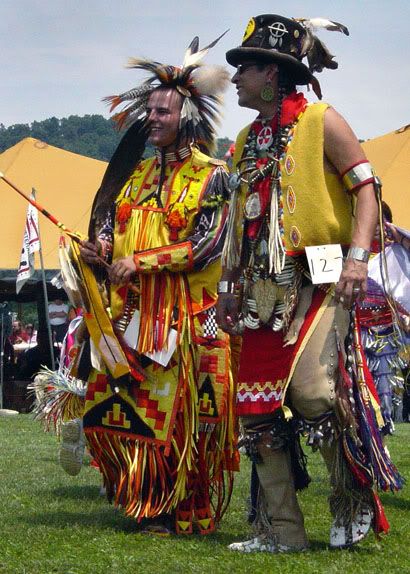
A PowWow is an American Indian gathering focusing on dance, song and family celebration. Traditionally, it is a celebration presented by one tribe or band to welcome and honor others. PowWows are usually three day weekend events, and people may travel great distances to attend. The main PowWow season is summer, and thanks to a resurgence of PowWows in the last decade, it is possible to Powwow every weekend, year round, in North America. All people (including non-Indian people) are welcome and are encouraged to attend. Experiencing a PowWow can be a valuable and fascinating cultural experience for those unfamiliar with our native peoples.
THE DANCES
THE DANCES
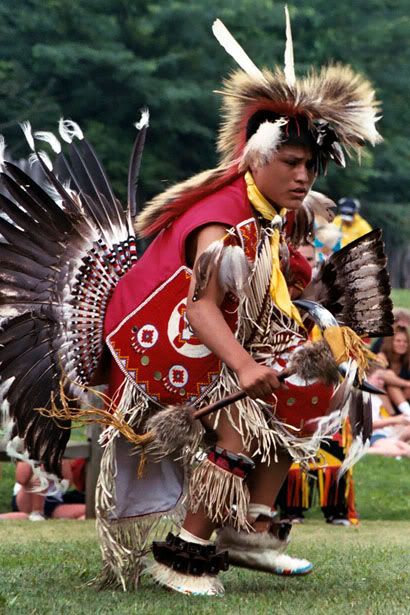

MEN'S GRASS DANCE
There are maby stories about the beginnings of the grass. One tells traces the roots of the grass dance back to the movements early scouts, secretly searching thru tall grass, yet untrodden by any moccasin. Dancing to flatten the grass and make it acceptable for a new camp or meeting site, their movements were immortalized in the grass dance.
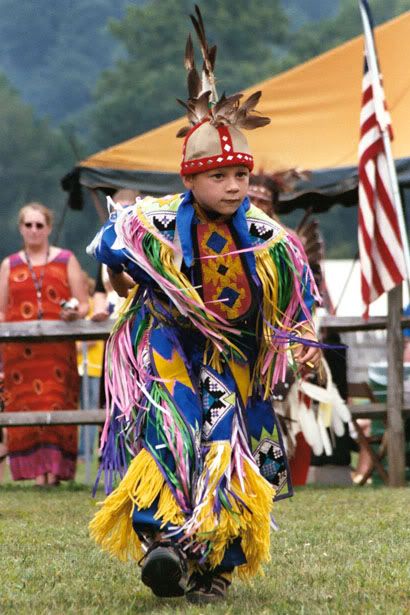
The movements also reflect those of a warrior stalking game or fighting an enemy (including a movement representing one of the warrior's legs being staked by his opponent, unable to move, yet continuing to battle with this leg held in position).

This dance reflects the need for balance in life; each movement danced on one side must be repeated on the other side. Some people talk of the grass dance as a gift from the Creator to celebrate joy. There is rich lore surrounding this dance. The regalia for the dance is comprised of long strands of yarn, ribbon or fabric attached to a base outfit to represent grass or in some theories the scalps of enemies. A headdress called a roach is worn with two feathers attached so that they rock or twirl as the dancer moves. As in all the dances, the dancer must move with the beats of the drum ending with both feet on the ground on the final beat.
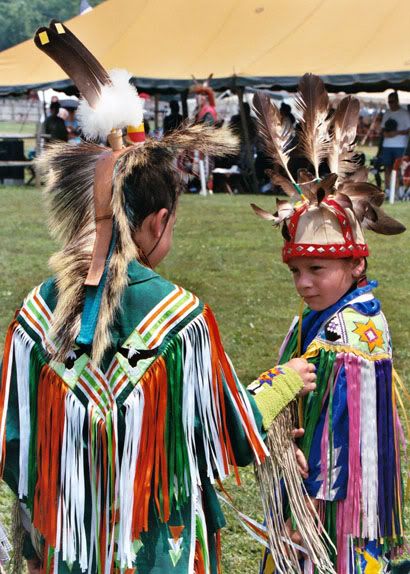
MEN'S TRADITIONAL DANCE
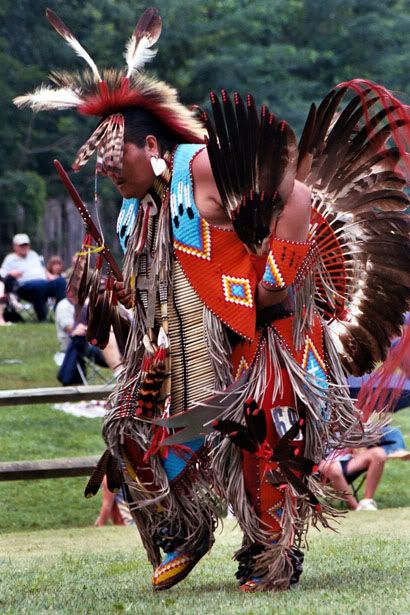
The oldest form of dance in the Indian culture, traditional regalia is often thought to represent the animals that the Creator put on the earth. The movements recall the warrior hunting, stalking his game, and battling an enemy.
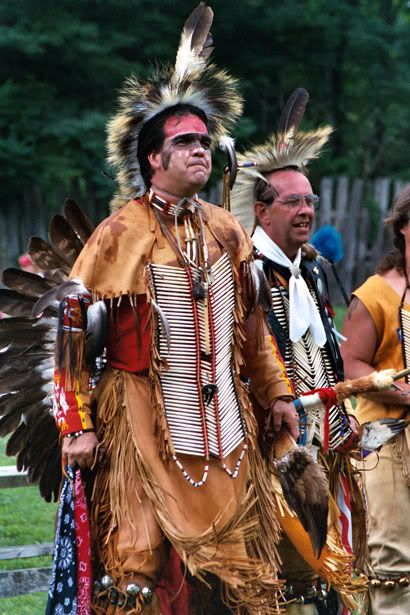
The regalia is a very per onal expression of creativity and artistry. Several elements might reflect items worn by early warriors: a breast plate made of animal bones or shell for protection against arrows; a neck choker for protection against knives; ankle bells or jingling hooves; or a shield made of hide and decorated with important tribal symbols.
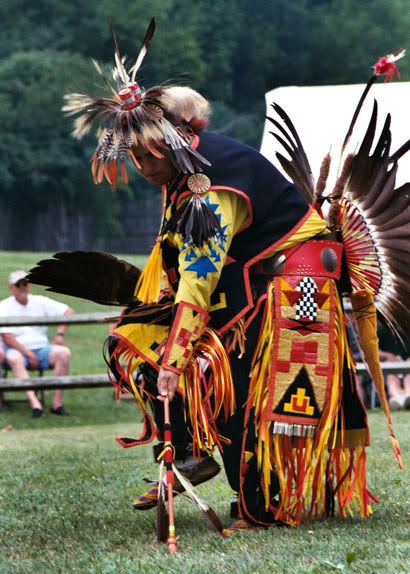

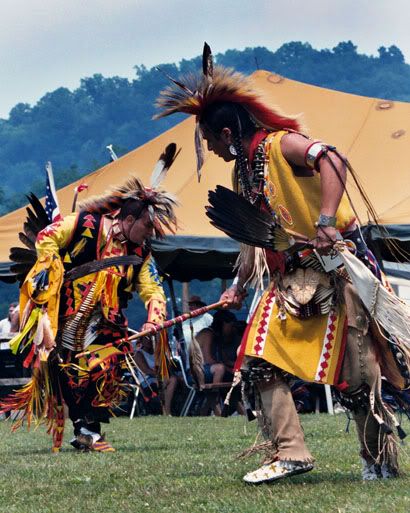
Often a traditional dancer will wear a single bustle containing eagle feathers, which are considered sacred to the Indian people. The eagle flies the highest and carries the prayers of the people to the Creator. Eagle feathers are traditionally awarded for feats of bravery or accomplishment.
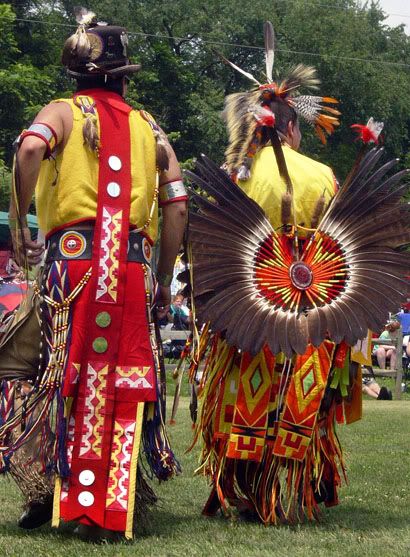
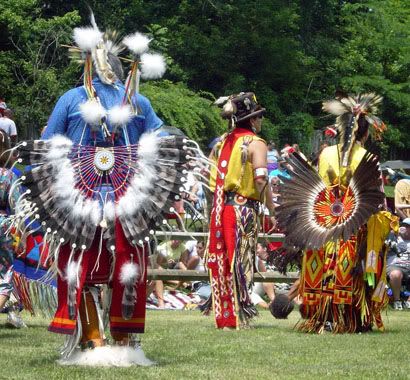
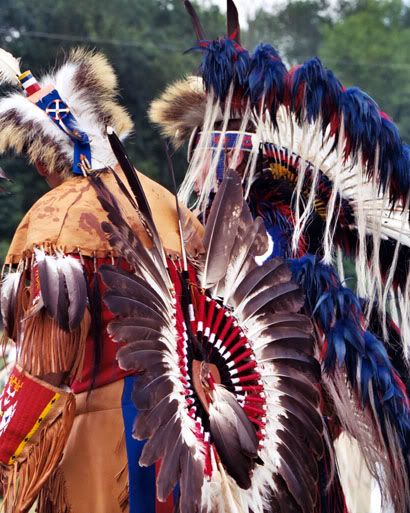
WOMEN'S TRADITIONAL DANCE

Woman's traditional dance requires enormous stamina, concentration and grace. The movements are very focused. Women move their feet in time with the drum keeping them close to the ground. As the drum plays "honor beats," women raise their fans to honor th e drum and their male relatives. An important element of women's traditional dance is the regalia. Women's traditional regalia will usually include a fringed shawl held gracefully folded over one arm, an awl and knife case on the belt and a feather (often eagle ) fan.
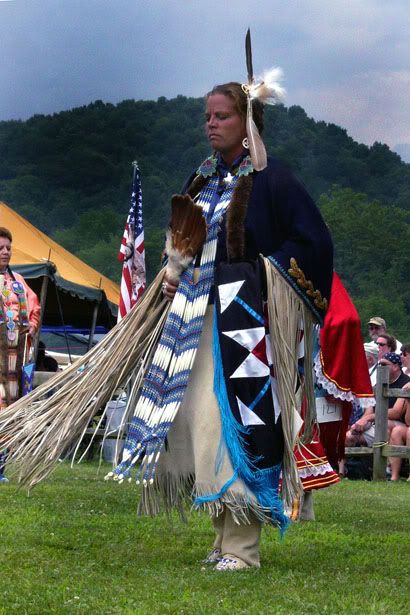
Southern or Oklahoma style women's traditional often feature buckskin or cloth outfits to go with their more overt rhythmic dance movement. The regalia will feature beautiful beadwork (usually created by the woman dancer) in patterns and colors that reflect tribal and family affiliation. Dakota patterns, for instance, often are in rainbow colors and geometric in shape, representing the colors and patterns of their homeland on the plains. The Ojibwe or Winnebago ragalia often reflect floral patterns and woodland colors showing the woodland Indian influence.
WOMEN'S JINGLE DRESS

This dance has its origins in northern Minnesota and was introduced to the Pan-Indian community by the Ojibwe people. As the story goes, a medicine man's granddaughter was very ill. He had a dream in which a spirit wearing the jingle dress came to him and told him to make one of these dresses and put it on his daughter to cure her. When he awoke, he and his wife proceeded to assemble the dress as described by the spirit of his dream. When finished, they and others brought his granddaughter to the dance ha ll and she put on the dress. During the first circle around the room, she needed to be carried. During the second circle around the room, she could barely walk and needed the assistance of several women. The third circle around the room she found she coul d walk without assistance and during the fourth circle around the room, she danced.
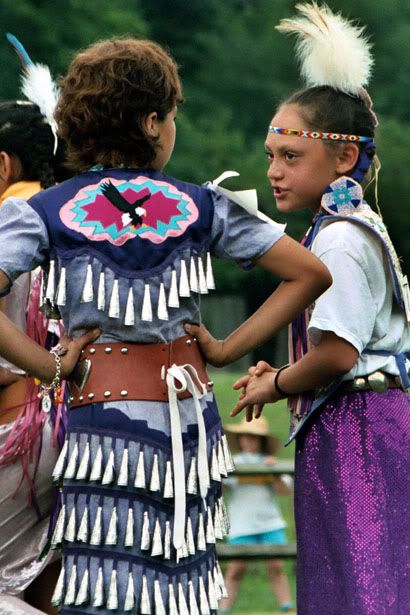
The jingle dress is made of a cloth, velvet or leather base adorned with jingles made out of a shiny metal. Traditionally and still common today, the jingles are made from the lids of snuff cans. These are bent and molded into triangular bell shapes and attached to the dress with ribbon or fabric in a pattern designed by the dancer. It takes between 400 and 700 jingles to make an adult jingle dress. The dance itself is designed to incorporate the sound of the jingles by allowing them to move, jingle, or be made "happy." The steps are controlled and do not invlove high kicking or twirls. Often the steps are in a zigzag pattern t o reflect the zigzagging involved in the journey of life. Similar to Men's Grass dancing, the feet often do parallel movements.
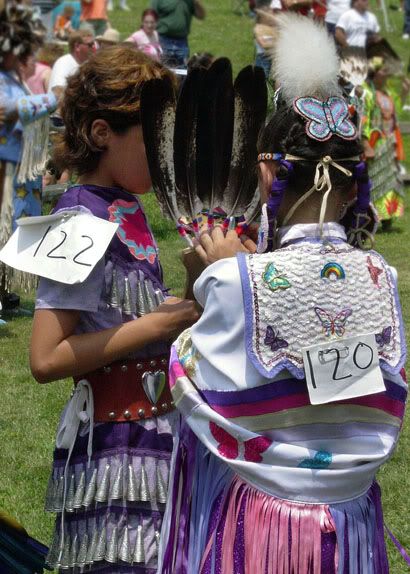
Similar to a Women's Traditional dancer, the Jingle Dress dancer also raises her fan when the "honor beats" are played on the d rum. As in all dances, the Jingle Dress dancer must stay in time with the drum beat and stop with both feet on the ground on the final beat.
MEN'S FANCY DANCE
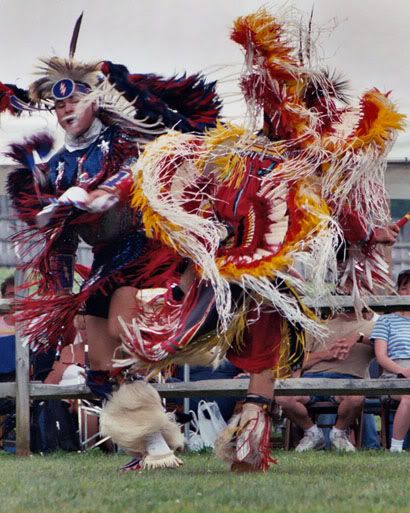
One of the more modern dances in the PowWow, Men's Fancy dance is the most strenuous and athletic. To be good at this dance, the dancer must train for stamina and agility.
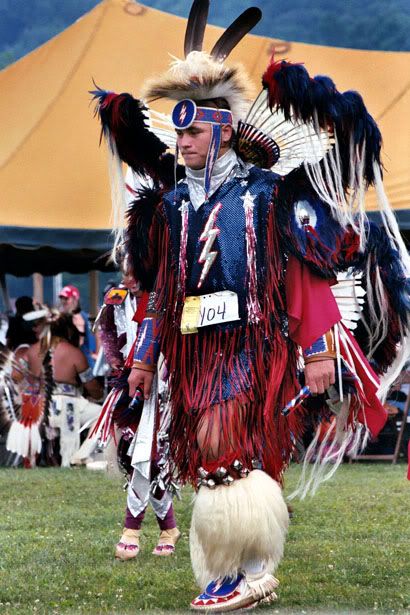
The dance is fast and features jumps and twirling. The regalia is said to represent the rainbow spirits in its bright colors and flying feathers and ribbons. The Men's Fancy dancer typically wears two bustles of bright colored feathers with added ribbon, feather or horse hair hackles and bright arm and head bands repeating the colors and patterns. The dancer also wears a headdress roach trimmed in colored horsehair and featuring two eagle feathers.
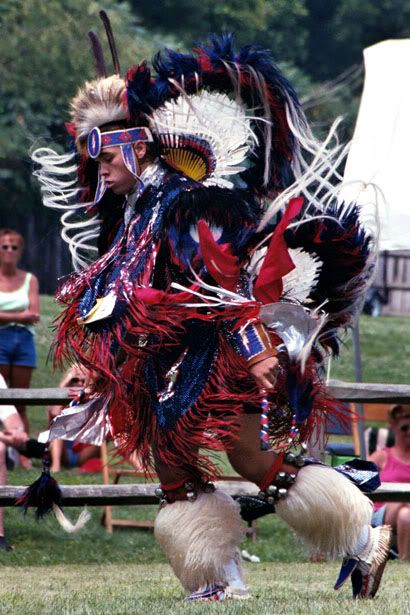
The roach is designed to keep the feathers either spinning or rocking in movement. It is part of the dance to keep the feathers moving constantly throughout the song. Dancers also carry coup sticks which are highly decorated with ribbons or feathers. The coup stick was originally a small stick carried into battle by a warrior. It was considered a great sign of bravery if you were able to touch your enemy with your coup stick (much more brave than killing your enemy).

WOMEN'S FANCY SHAWL DANCE

This is the most modern of the women's dances. Some say it was originally called the blanket dance and women danced with a blanket or shawl covering their heads. It was called Graceful Shawl dance in the '60s and the dance steps were closer to the ground and smaller than what is performed today.
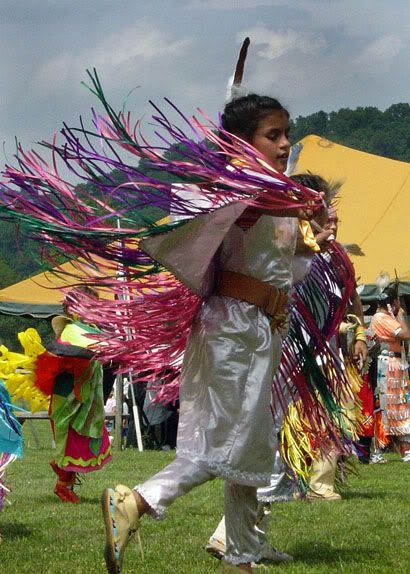
This is an extremely athletic and strenuous dance involving kicks and twirls and fast movement. It parallels the Men's Fancy Bustle dance in speed and style. Women dance with beautifully decorated shawls often with long ribbon or fabric fringe. The regalia of this dance also includes beaded high moccasins. The symbols and colors beaded on the moccasins have tribal and or personal significance to the dancer.
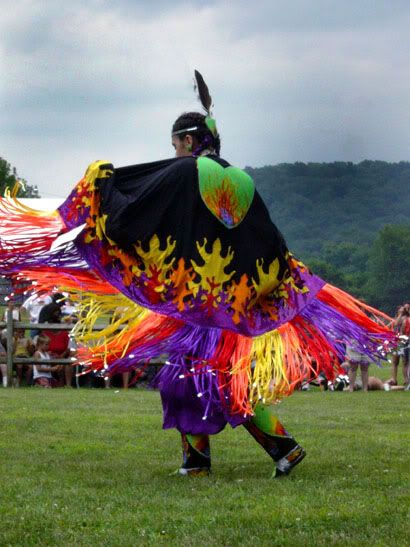
Most importantly, PowWows are keeping the old ways alive, preserving and passing them on to future generations.

A father and his son.
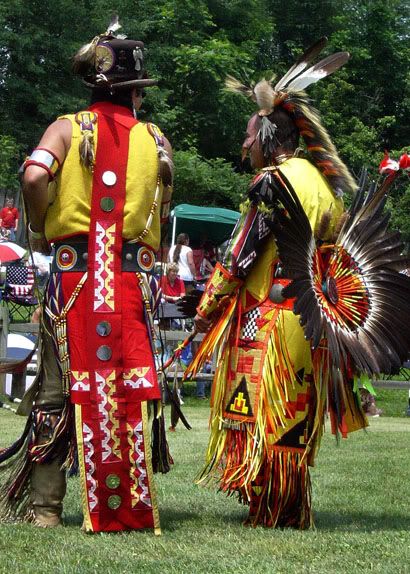
An elder and a teenager share the bond of their native cultures.


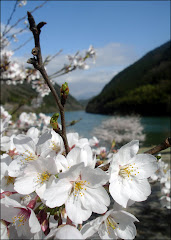

6 comments:
wow. you have very nice and colorful pictures. i am jealous. nice writing too. interesting.
Fantastic. Truly aweinspiring thanks for sharing.
Hello from Cherokee, North Carolina--Very nice pics hun--and to see these dances--they are very colorful and true to each's own tribe--they are have meaning--thank you for the pics--just passing though-I work with a dear friend--and was looking up some information and came across your site--Sgi(Thank you in Eastern Cherokee) from Runningbear and Snoopycathy
nice page, just want to provide a correction to you regarding the information stating that it takes "400 to 700 jingles to make an adult jingle dress".....although not always strictly followed due to the size of the wearer of the dress, the traditional number of jingles for a jingle dress is 365, one for every day of the year...just thought you'd like to know.
The whole 365 thing is incorrect. That is the Roman calendar and not "traditional" at all. Back in the day, the year was never defined by natives as 365 days.
Post a Comment